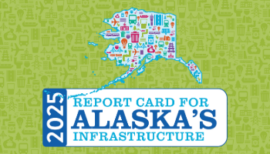Inland Waterways
Startup Uses Drone for Cleaning Water, Collecting Data

Montana’s infrastructure is the foundation that supports its growing economy, connects its communities, sustains tourism, and fosters resilience across both urban and rural areas. However, Montana’s vast geography and unique landscape bring distinct challenges. The state spans over 147,000 square miles and includes over 27 million acres of public lands, 7 American Indian reservations, 9 national forests, and 2 major national parks—Glacier and Yellowstone. These areas attract visitors and define Montana’s natural heritage, but also demand specific infrastructure solutions to support access, safety, and environmental stewardship.
Montana’s infrastructure has historically faced underinvestment, leading to deferred maintenance and increased pressure on essential systems. However, recent initiatives have sparked critical improvements. Montana has benefitted from federal investments such as the 2021 Infrastructure Investment and Jobs Act (IIJA) and the 2022 Inflation Reduction Act (IRA). These, alongside other funding sources, have infused $8 billion into state infrastructure – plus $2 billion more from the private sector. These investments targeted urgent needs, including replacing aging water lines, modernization of transportation networks, and expanding broadband access in rural and remote areas.
Improving Montana’s infrastructure requires careful planning and strategic funding solutions. Montana’s infrastructure must also adapt to risks from extreme weather events, public health imperatives such as removing lead water lines, and new environmental challenges such as “forever chemicals” in water supplies.
The 2024 Report Card on Montana’s infrastructure provides a snapshot of the state’s current infrastructure landscape, capturing areas of progress and identifying challenges that remain. This report emphasizes that continued long-term investment across all infrastructure categories is vital to support Montana’s future. Addressing these critical infrastructure needs will enhance public safety, boost economic resilience, and improve the quality of life across Big Sky Country. This report calls for coordinated efforts between residents and decision-makers to build a resilient, inclusive, and sustainable future for every Montanan.
Montana’s public aviation system comprises nearly 130 airports: eight primary service, four commercial service, and 117 general aviation airports. These facilitate the movement of passengers and cargo and provide medical evacuation services, agricultural support, and bases for wildland firefighting. Enplanements at primary and commercial service airports grew 19% from 2019 to 2023, amid population growth in the state. All primary airports have been expanded, rehabilitated, or begun new terminal construction projects in the last five years. Pavement conditions on runways, taxiways, and aprons rated satisfactory on average in 2021, but those surfaces are aging, necessitating continued preservation work. Over the last 20 years, federal funding for state airports jumped from $36 million in 2003 to $63 million in 2020, and an average of $113 million from 2021 through 2023. State grant funding increased tenfold to $2.3 million in 2023 following a 2020 aviation fuel tax increase. Workforce development, proactive planning, and partnerships with sustained funding will improve state airports.
Montana has over 5,200 bridges, with state-owned structures averaging 50 years in age. The overall condition of bridges – categorized as good, fair, or poor – remained relatively stable between 2019 and 2023, with 15% requiring immediate repairs in both analysis years. However, the number of load-posted or closed bridges has steadily increased, now totaling 600 and growing by 10% to 20% annually. In Montana’s rural areas, detours for closed or restricted bridges, when available, can add substantial distances to trips. Ownership influences the severity of the issue: while only 2% of state-owned bridges are load-posted or closed, 20% of locally owned bridges face these restrictions. Recent federal investments and the 2023 Montana Legislature’s passage of three bills to increase tax revenue for state and local bridge maintenance have provided some relief. Nevertheless, a significant funding gap remains. Over the next decade, anticipated funding of $535 million falls far short of the $4.4 billion needed to address Montana’s bridge infrastructure needs.
Montana has made considerable progress in the past several years to address deficiencies in broadband throughout the state, though it is ranked at the bottom nationally in overall access. Only 71% of locations served by internet service deliver today’s speed standard of 100 MBps download and 20 MBps upload, compared to the national mark of 93%. In 2021, the Montana Legislature directed $275 million into broadband projects from 2021’s American Rescue Plan Act. The Infrastructure Investment and Jobs Act passed by Congress that same year will deliver at least $775 million of broadband investments, including almost $100 million in Tribal communities. Montana’s Governor and the Montana Broadband Office have enhanced planning efforts with a target to make broadband accessible statewide by 2030. Adoption of broadband connections lags accessibility, in some cases, because of affordability and computer literacy gaps. To complete the deployment of these federal and state investments and earn a letter grade, decision-makers should collect more data on broadband infrastructure condition, capacity, reliability, and resilience.
Montana’s geography and varied climate mean the state’s more than 3,000 dams represent an inventory 50% bigger than any other western state. 81% are privately owned, 10% are federally owned, and only 5% are state-owned, posing challenges to Montana leaders. Out of 3,000 total, 206 are High-Hazard Potential (HHP) potentially threatening life should they fail. Of these 206 HHP dams, 81 have federal owners, and 78 possess Emergency Action Plans (96%), compared to 91% of the HHP dams owned by Montana with those plans. Dams are aging in Montana, with an average age of 70 – beyond the common 50-year design life. Funding is limited to improve these structures. 2021 data showed that eleven state-owned HHP dams required work that could take more than a decade to be funded. Private owners managing the bulk of dam inventory have even less access to public funds. Montana decision-makers should prioritize and remedy the areas of greatest risk with increased funding and nurture the workforce necessary to deliver.
Montana has nearly 2,300 water systems, operated by both public and private entities, which include various water treatment, distribution, and storage facilities. These systems serve over one million residents, as well as the state’s vital tourism and recreation industries. While several of Montana’s larger cities have recently completed significant upgrades to their water treatment plants and distribution systems, much work remains. The Environmental Protection Agency (EPA) estimates that Montana will need $2.3 billion for water infrastructure improvements, with the greatest needs being in treatment and storage. In recent years, the total annual funding for water and wastewater projects in Montana has averaged over $250 million, up from $160-$170 million annually due to increases in federal funding. These funding levels must be maintained to meet the EPA’s goals for infrastructure improvements that are needed in Montana. Additionally, Montana faces challenges related to a decreasing number of certified water operators. There is a critical need for recruitment and training to fill the growing demand for these professionals. Furthermore, new regulations require Montana communities to conduct lead service line (LSL) assessments, remove lead in water lines, and comply with emerging contaminant limits (e.g., PFAS), all of which are expected to further increase costs.
Montana’s energy infrastructure is a diverse mix of coal, petroleum, natural gas, hydro, and renewables like wind and solar. The state ranks 4th in the nation for per capita energy consumption due to its energy-intensive industries, long travel distances, and harsh winters. Montana exports approximately 40% of its electricity, primarily to neighboring western states, making it a key player in the regional energy market. Despite its resources, Montana faces challenges in modernizing its grid to support growing renewable energy projects, ensure reliability, and meet increasing demand driven by population and tourism growth. Grid modernization, renewable energy development, and careful policy planning are crucial to securing Montana’s energy future. By investing in innovative technologies and leveraging federal and private funding, Montana can enhance the resilience, sustainability, and affordability of its energy infrastructure.
Montana has been increasingly active in managing and remediating hazardous waste sites in response to rising industrial activity, population growth, and stricter environmental regulations. The state is home to 18 Superfund sites listed on the National Priority List (NPL), hundreds of permitted hazardous materials sites and cleanup projects, thousands of underground storage tanks, and numerous brownfield sites. Montana has successfully leveraged funding from federal programs, including the Infrastructure Investment and Jobs Act (IIJA) and the Leaking Underground Storage Tank Fund (LUST), to support environmental cleanup and promote economic revitalization. State agencies are incorporating sustainability practices into infrastructure projects and adopting waste minimization strategies to address significant challenges posed by climate change. These challenges include increased storms, flooding, and rising temperatures, which threaten vulnerable hazardous waste sites. Despite these efforts, Montana faces ongoing difficulties in securing adequate funding and resources to address all hazardous waste management needs. New site identifications and evolving regulatory requirements further compound these challenges, emphasizing the need for continued investment and innovative solutions.
Montana, renowned for its vast landscapes spanning over 30 million acres of state and federal lands, is a paradise for outdoor enthusiasts. The state is home to two national parks, Glacier and Yellowstone, with Glacier accounting for 3 million of the 5.7 million total national park visits in 2023. Montana’s state parks also attracted three million visitors in 2022, marking a 19% increase since 2019. This surge in outdoor recreation has placed a significant strain on park facilities and infrastructure. A 2024 survey rated road conditions in state parks at 7 out of 10 and water systems at 6 out of 10. Staffing shortages, driven in part by a lack of affordable housing for seasonal workers, have further hampered park operations and public safety efforts across local, state, and national parks. These challenges are compounded by budget constraints and rising costs for operations, maintenance, and capital improvement projects. Despite these hurdles, Montana remains committed to preserving its natural and cultural heritage while ensuring equitable access to outdoor recreation for both Montana residents and visitors alike.
Montana’s rail infrastructure serves as a crucial link in the transportation network, facilitating the movement of goods across the state and to international markets. With nearly 3,700 miles of track, Montana’s rail system supports the state’s agricultural, energy, and industrial sectors while connecting rural communities to larger economic hubs. Freight operations dominate, with Class I railroads owning over 70% of track in the state, and short-line and regional railroads providing essential first- and last-mile connections. Passenger rail is limited to Amtrak’s Empire Builder, which traverses the Hi-Line region. While Montana’s rail infrastructure plays a vital role in the economy, it faces significant challenges, including aging infrastructure, capacity limitations, insufficient safety measures, and vulnerabilities to extreme weather events. Federal funding and innovative technologies offer opportunities for modernization, but targeted investment and coordinated planning are essential to meet current and future demands. Without action, Montana’s rail network risks losing its ability to sustain economic growth, ensure public safety, and adapt to evolving transportation needs.
Montana’s highway system is a critical asset that supports travel, recreation, and commerce, making it a cornerstone of the state’s economic vitality. The road network includes almost 13,000 miles of state highways and interstates, managed by the Montana Department of Transportation (MDT), as well as over 63,000 miles of county, municipal, and tribal roads. Despite its importance, long-term funding levels fall short of the need, with needs outpacing available revenue by a ratio of 3:1; thus, jeopardizing the future of Montana’s transportation system. Population growth and increased vehicle miles traveled (VMT) further stress this infrastructure, underscoring the urgency of addressing systemic funding challenges. To secure the future of Montana’s transportation network, increased funding from all levels of government, expanded preventative maintenance, and the adoption of advanced construction technologies are essential. Without decisive action, the state risks jeopardizing public safety, economic growth, and quality of life. A long-term commitment to investment and innovation will ensure a sustainable and resilient road system for future generations.
Montana has 826 K-12 public schools that serve over 149,879 students, with facilities averaging 53 years in age. Two-thirds (68%) of these schools were built before 1970, highlighting a growing need for repairs and upgrades. While funding is available for critical safety issues, the Montana School Facility Reimbursement Program, which supports general maintenance, has experienced reduced revenue since 2010. This has created significant funding gaps for routine repairs, code compliance, and energy efficiency improvements. The challenges are further compounded by rising energy costs and declining student enrollment, placing additional strain on already tight school budgets. As a result, Montana’s schools are struggling to meet the demands of their aging infrastructure while providing a safe and healthy learning environment for students. Addressing these issues requires sustained investment and innovative solutions to modernize facilities and support the long-term success of Montana’s education system.
Montana residents generated approximately 1.5 million tons of municipal solid waste (MSW) last year, a per capita waste generation rate of 8.2 pounds per person per day, significantly higher than the national average. The state operates 31 landfills, and a total landfill capacity of about 30 million tons is unevenly distributed. Some regions are nearing or at capacity, highlighting a need for expanded waste management solutions and infrastructure upgrades. Montana’s recycling infrastructure is limited, with only around five material recovery facilities (MRFs) and a recycling rate of about 19%, well below the national average of 32%. Additionally, less than 1% of MSW is converted to energy, indicating a potential area for development in waste-to-energy practices. Funding gaps in the solid waste management system, such as insufficient resources for innovation and infrastructure development, highlight the need for improved investment and strategic planning to advance sustainable waste management practices.
Montana’s rural character and diverse landscapes make managing stormwater runoff a significant concern. While local stormwater utilities help address these challenges, their effectiveness is limited as Montana’s 14 permitted districts cover only the state’s few urban areas. Many smaller communities lack the capacity and funding to address local stormwater issues effectively. The Montana state government works with these districts to ensure that construction sites, urban areas, and industrial operations implement pollution control measures. However, agricultural runoff—often containing fertilizers, pesticides, and sediments—remains largely unregulated, posing a significant source of contamination. The full cost of implementing more robust stormwater management remains unclear. In 2022, the Environmental Protection Agency (EPA) estimated Montana’s stormwater infrastructure needs at $22 million, though state-reported data may underestimate the costs of addressing urban runoff and mitigating agricultural pollution. Compounding these challenges, Montana’s 2017 Climate Assessment predicts more severe precipitation events and increasingly unpredictable seasonal patterns, which existing systems—often designed with outdated data—cannot effectively manage. Addressing Montana’s stormwater needs will require greater funding, improved regulatory coordination, and enhanced infrastructure design to create resilient systems capable of withstanding these evolving challenges.
Montana’s wastewater infrastructure is a mix of public and private systems. Approximately 616,000 residents, or 58% of the state’s population, are served by around 500 public wastewater systems, while private septic tanks and drain field systems serve the remainder. Although several of Montana’s largest municipalities have completed significant upgrades benefiting about 25% of the population, many other systems—particularly those relying on lagoon treatment—have not been updated in over 30 years. The Environmental Protection Agency’s (EPA) 2023 Clean Watersheds Needs Survey estimates that Montana requires $347 million in wastewater improvements, particularly in collection systems, lift stations, and advanced treatment upgrades. While recent federal legislation, including the American Rescue Plan Act (ARPA) and the Infrastructure Investment and Jobs Act (IIJA), has boosted funding, a substantial gap remains. Continued investment and innovative approaches are essential to meet the state’s growing wastewater infrastructure needs and ensure environmental and public health protection.
A: EXCEPTIONAL, B: GOOD, C: MEDIOCRE, D: POOR, F: FAILING
Each category was evaluated on the basis of capacity, condition, funding, future need, operation and maintenance, public safety, resilience, and innovation

Aviation
$17 million in 2022 airport improvement grants across 9 major airports

Drinking Water
$2.3 billion total drinking water need

Transit
2.2 million passenger trips across 46 systems in 2021

Bridges
5,266 bridges, 6.9% of which were structurally deficient in 2021

Hazardous Waste
19 Superfund sites

Wastewater
$363 million total wastewater need

Dams
204 high hazard dams

Levees
85 miles of levees protect 24,300 residents.

Roads
30% of roads are in poor or fair condition
Smart investment will only be possible with strong leadership, decisive action, and a clear vision for our nation’s infrastructure.
If the United States is serious about achieving an infrastructure system fit for the future some specific steps must be taken, beginning with increased, long-term, consistent investment.
We must utilize new approaches, materials, and technologies to ensure our infrastructure can withstand or quickly recover from natural or man-made hazards.

Alaska Infrastructure Grade Improves to ‘C’
February 27, 2025
This week, ASCE members from Alaska released the 2025 Report Card for Alaska’s Infrastructure. In this third Report Card for The Last Frontier, the overall...

Texas Infrastructure Rates at “C” in 2025
February 20, 2025
On February 18 at the Austin Capitol Building, ASCE members released the 2025 Report Card for Texas Infrastructure. The press conference featured updates to the...
 Link to Post:https://infrastructurereportcard.org/trump-signs-executive-orders-to-begin-second-term-creating-uncertainty-for-iija-spending/">Trump signs executive orders to begin second term, creating uncertainty for IIJA spending
Link to Post:https://infrastructurereportcard.org/trump-signs-executive-orders-to-begin-second-term-creating-uncertainty-for-iija-spending/">Trump signs executive orders to begin second term, creating uncertainty for IIJA spendingTrump signs executive orders to begin second term, creating uncertainty for IIJA spending
January 30, 2025
Since assuming office last week, President Trump has signed several executive orders related to various policy topics, including energy, climate, and infrastructure. Among those actions...